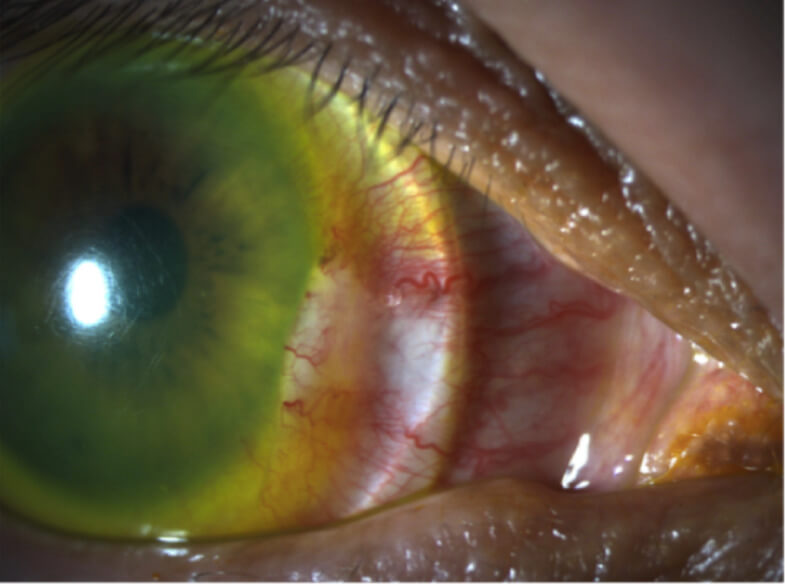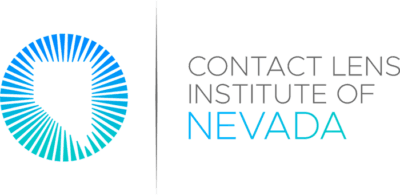What is the sMap 3D?
The sMap 3D is a special instrument that some eye doctors have to assist with custom scleral lens fitting.
The sMap is a type of machine called a scleral topographer, or a scleral profilometer. Unlike a traditional topographer (which many eye doctors have), a scleral topographer maps the white part of the eye, called the sclera.
A traditional corneal topographer can be found in many eye doctor’s offices. This machine takes an image of the front part of your eye, called the cornea. Based on the image, this instrument gives your doctor precise measurements of every single part of your cornea. The result is a colorful map. The colors on the map correspond to different curvatures, which you can see on the color scale to the left. Each color represents a different number on the scale. This tells the doctor how steep and how flat different portions of your cornea are.

Corneal Topography shows a color map and a scale to match the curvature of the cornea
Topography is very important for patients who have corneal defects or surface disorders. The measurements displayed from mapping the front surface of your eye give the doctor important information about the shape of your eye. This information is also used to detect and manage eye diseases.
Regular topographers only capture the curvature of the cornea, the clear membrane that lays above the iris, the colored part of your eye. Regular topographers do not give doctors any information about the curvature of the white part of your eye, called the sclera.
Doctors who specialize in medically necessary contact lenses figured out that more information was needed from the scleral shape to fit the patient into the best possible scleral lens.
Scleral topographers or scleral profilometers are able to map the WHITE part of the eye. This is very valuable for your eye doctor because it tells them the precise curvature of the sclera.
Some patients have a lot of astigmatism on their sclera. There is not an official correlation to corneal astigmatism and scleral astigmatism, but more research is being done on that topic.
Some patients have a very IRREGULAR scleral shape. This presents a problem for a traditional scleral lens. The reason a traditional scleral lens may not work is because the parameters of scleral lenses are somewhat limited. Regular scleral lenses cannot accommodate specific elevations sometimes.

The sMap is an amazing machine that allows us to capture over 1 million data points from your scleral shape. This information is then used to create a very custom scleral lens.
What to expect for your sMap imaging visit:
It is important NOT to wear any contact lenses for at least 24 hours prior to your appointment. This is because many contact lenses can alter the shape of your eye and give the doctor inaccurate measurements. Think about if you wore a tight fitting sock. When you remove the sock, there are a lot of wrinkles and lines on your skin where the sock was compressing too much. If you were to take an image or mold of your foot and ankle right after you removed your sock, it would not be accurate. But if you waited a few hours, your skin will have bounced back to its original shape and the image would now be accurate. The same thing holds true with your eye. The tissue on your eyeball is very squishy, so it is easy to alter. Please refrain from wearing a contact lens for at least 24 hour prior to your appointment.
At your appointment, your doctor will then instill some yellow dye into your eye. The machine uses the reflection of the yellow dye to capture the image. Next, you will look straight into the camera while holding your lower lid, while your doctor holds your upper lid. The first image will then be taken. After that, you will repeat this process by looking down and then up and capturing more images at those gazes.
After the images are captured, the sMap machine will analyze the data and help the doctor map your scleral shape. This information also helps the doctor select an initial scleral lens to try on.
Once the doctor has the lens on your eye, they will find out what your prescription is, so they can order your specific power.
The scans from the sMap will then be sent to the lab, and special software will assist in designing your lenses. The result is a very custom scleral lens.

Good Candidates for the sMap technology and the Latitude Scleral Lens:
- Patients with a highly toric scleral shape
- Patients with conjunctival anomalies such as pinguecula, pterygium, ocular trauma, glaucoma surgeries, and other irregularities.
- Patients who get constant redness with their current scleral lenses
- Patients who feel their scleral lenses are really stuck to their eyes when they try and remove them
- Patients who get fogging behind their current scleral lenses very quickly after insertion
- Patients wanting a custom fit scleral lens
- Patients desiring the best comfort and vision that scleral lenses have to offer
- Patients who do not want to constantly come back to their eye doctor for visits over and over again for scleral lens adjustments
View a success story with a patient who used the sMap technology to create a perfectly fit scleral lens here.


